Sapota is also commonly known as “Chiku,” and it is an important fruit crop in India. Sapota is more nutritious because it is an evergreen tree. The need for fertilizer varies with the size of the plants. All healthy Sapota trees are heavy feeders that remove large amounts of minerals from the soil. Let’s check out fertilizer management in Sapota/Sapodilla below.
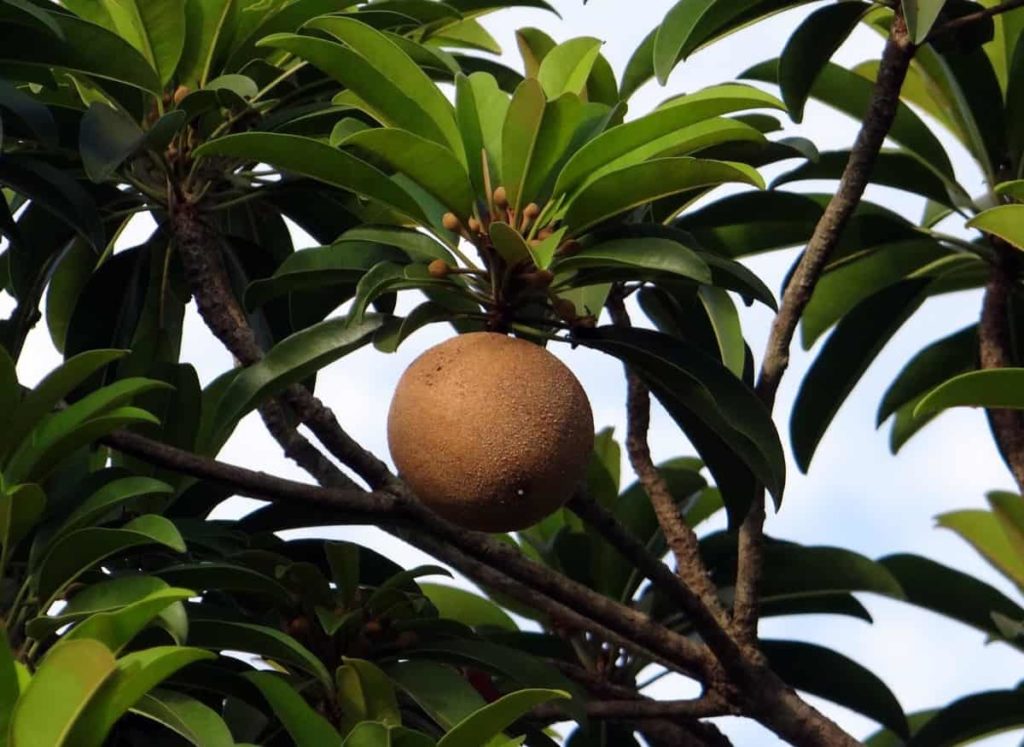
Although all plants need 16 essential nutrients, Sapota trees pay the most attention to macronutrients. It is important to change these nutrients regularly to keep trees strong and healthy. The macronutrients we need to use regularly are Nitrogen, Phosphorus, Potassium, Calcium, Magnesium, and Sulfur.
Also, carbon, hydrogen, and oxygen are required in large quantities, but they are provided by air, water, and organic matter. Fruits are a good source of digestible sugars (15-20%) and a valuable source of protein, fat, fiber, and minerals (Ca, P, and Fe). Sapota is commercially propagated by plant methods such as air or gootee layering, grafting, and budding. The crop can be planted in areas with high rainfall by the end of September.
Sapota is adapted to tropical and warm subtropical climates and requires warm (10 ° -38 ° C) and humid (70% relative humidity) climates where it flowers and bears fruit all year round. Sapota plants adapt well to a wide range of soils but thrive in well-drained, light soils. Trees are especially suited to rocky, highly calcareous soils.
Fertilizer management in Sapota/Sapodilla
Best organic fertilizer for Sapota trees
Sapota trees prefer an organic and high nitrogen fertilizer. Composted chicken manure, blood meal, soybean meal, cottonseed meal, and feather meal are all good sources of organic nitrogen. The soil is an organic entity constantly changing and adapting to its environment. Although microorganisms and insects increase their nutritional value, they sometimes dwindle and cannot provide the nutrients different plants need.
In such cases, applying organic fertilizer is necessary to ensure plants’ healthy growth. These natural things are readily available, and it rarely takes time to make fertilizer from them. If used regularly, your soil will have a marked increase in phosphate, potassium, and calcium content, which will help beloved plants to bloom brightly. Apply any organic fertilizer to increase fertility.
NPK fertilizers for Sapota trees
Sapota plants need fertilizer and manure for healthy growth and development. These Sapota plants are fertilized twice a year in June and January. Fully grown Sapota trees need about 100 kg of FYM, 10 kg of biomeal, and 1 kg of micronutrient compounds. Sapota trees require foliar sprays of NPK, Mg, and Zn during the fruit set period to improve fruit size. Nitrophoska 8: 12: 24: 4 by 100 gm/tree use is beneficial for the growth of Sapota trees.
In case you missed it: Top 15 Steps to Boost Sapota/Sapodilla/Chiku Yield: How to Increase Fruit Size, Quality, and Production
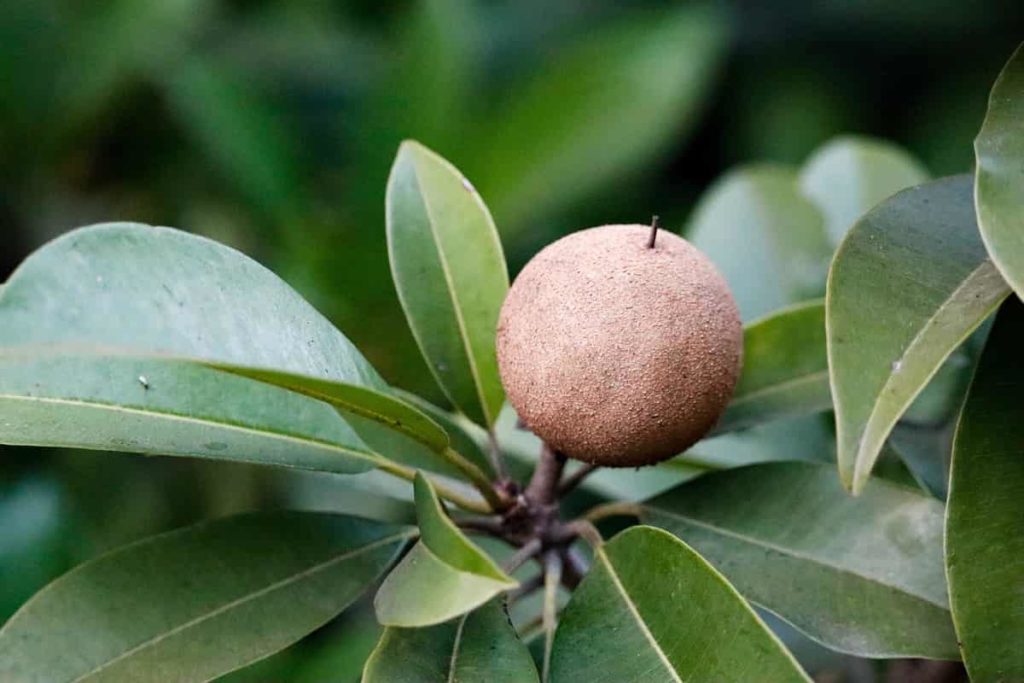
In addition to the recommendations mentioned above for using fertilizers, there are some standard recommendations for fertilizing Sapota trees. 1 year old Sapota plant needs 10 kg FYM, 0.2 kg N, 0.2 kg P and 0.3 kg K. Annual increase in fertilizers and fertilizers FYM @ 10 kg, N @ 0.2 kg, P @ 0.2 kg and K @ 0.3 kg per tree. From the sixth year, the trees need 50 kg FYM, 1 kg N, 1 kg P, and 1.5 kg K. In rainy conditions, fertilizer is applied before the onset of monsoon.
In the case of irrigation, it should be applied in two parts, one half at the beginning of the monsoon and the other half after the monsoon (September to October). All these fertilizers should be provided to the plants in September and October. Fertilizers are applied at the tree’s base up to 45 cm from the trunk to the drop of leaves. In addition, about 40 kg of FYM and 5-10 kg of Neem-cake per plant are planted yearly. Foliar spray of micronutrients will increase growth and productivity.
Tips for fertilizing Sapota trees
Sapota trees do not appear to be demanding in their fertilizer requirements. After planting, when new growth begins, 1/4 pound (113 g) of young tree fertilizer such as 6-6-6-2 (% nitrogen-% phosphate-% potash-% magnesium) with 20 minor elements. Apply up to 30% of nitrogen from organic sources. And repeat this process every 6 to 8 weeks for the first year of planting, then increase the fertilizer amount to 0.5, 0.75, and 1.0 lb (227 g, 341 g, 454 g) as the tree grows. Use 4 to 6 minor (nutritional) foliar sprays each year from April to September.
Sapota trees are not usually deficient in iron, even when grown in the rocky, calcareous, high-pH soils. Apply the iron if there are signs of iron deficiency (chlorotic leaves with green veins). For trees in acid-neutral soil, apply 0.25 to 1 ounce of dry iron sulfate per tree (7-28 grams) in soil for 2 to 4 timers per year. Water the iron in the ground. In high pH, alkaline soils, wet the soil adjacent to the tree trunk with iron chelate 1 to 2 times a year from June to September.
For mature trees, it is recommended to apply 2.5 to 5.0 pounds (1.1–2.3 kg) of fertilizer per application about 2 to 3 times a year. Fertilizer mixes should include phosphate (P2O5) and potash (K2O). Use materials 6-6-6, 8-3-9, or similar. Use 2 to 3 minor (nutritional) foliar sprays each year from April to September.
Micronutrients for Sapota tree growth
In the case of micronutrients Zn and Fe deficiency, organic manures ZnSO4 and FeSO4 (0.5%) are applied. Mulching helps retain soil moisture and protects roots in freezing temperatures with a 3–5-inch layer of bark or wood chips. Keep the mulch about 8-12 inches from the bark for fully grown Sapota trees.
In case you missed it: Sapota Flower Drop, Fruit Drop Causes, Control
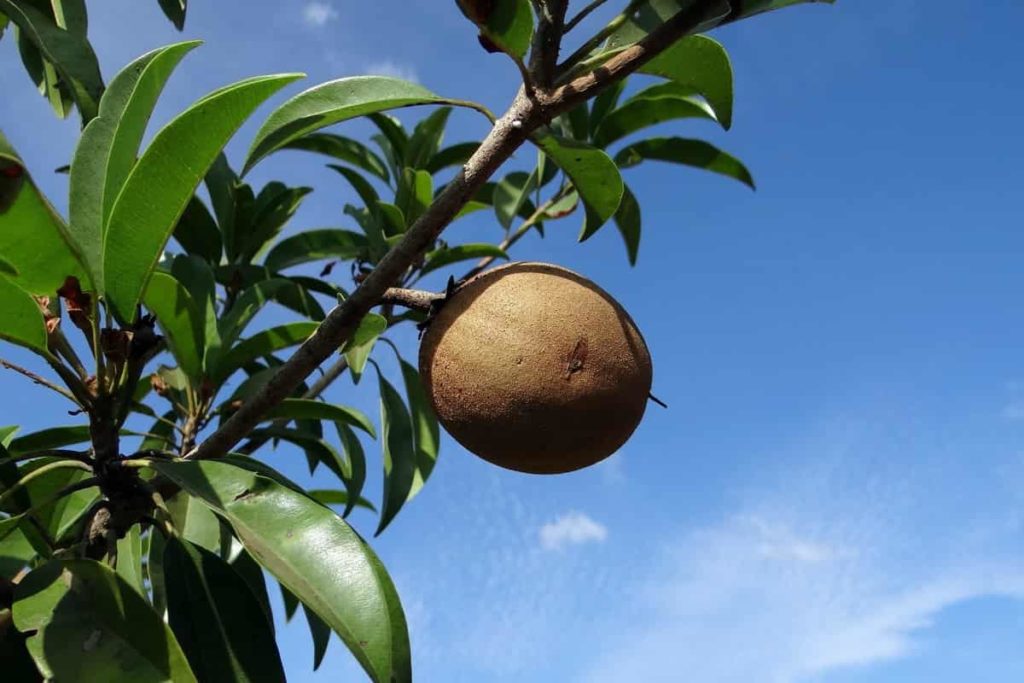
Fertilizer used to grow Sapota plant in containers
It is recommended that you apply fertilizer only when it is released on time 8-3-9 or similar so that your Sapota plant can grow and help produce enough crops. These Sapota plants are moderate feeders and require a lot of food during the growing season. It is necessary to follow the instructions on the fertilizer label as there is no need to burn or kill the spout tree.
Nutrients for different Sapota planting stages
Pre- planting
Based on soil test recommendations for specific agro-climates, nutrition should be applied before planting. Prepare the land by plowing, and pits are dug about a fortnight before planting in summer. After that, dig pits of about 1 m x 1 m x 1 m at a distance of about 10 m x 10 m (plants up to 5 x 5 m high density can be planted up to 13 years of age). Fill the pits with topsoil mixed with Trichoderma culture with 25 kg FYM.
Planting stage
Planting is done in pits with well-drained soil and in farmyard manure. Apply 20 grams of Azospirillum and mycorrhizae per plant during planting.
Time of fertilizer application in Sapota
Fertilizers and manures should be applied in two divided doses; the first is applied at the beginning of the monsoon in areas with dry rainfall. Split application occurs in trees that are carrying heavy crops. After fertilization, the top is covered with soil and irrigated.
In case you missed it: Sapota Pests, Diseases (Chiku/Sapodilla), Control Methods
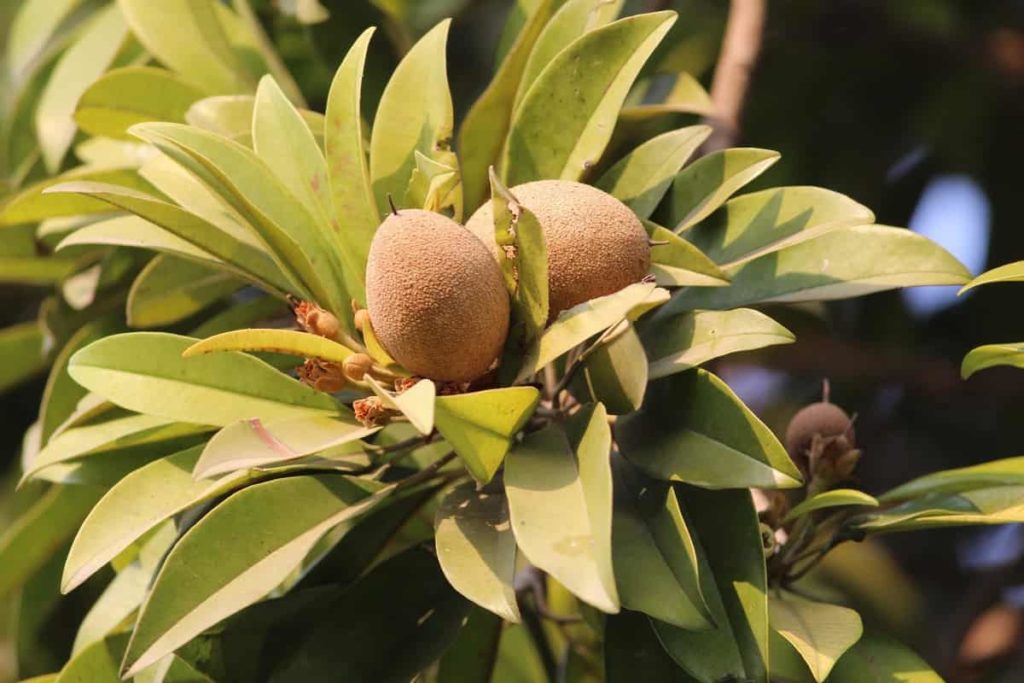
FYM is applied before or after the monsoon, and N, P, and K are applied twice a year. The first half is at the monsoon’s beginning, and the other half at the end of the monsoon. Doses vary due to soil type, climatic conditions, planting age, and management methods.
Method of fertilizer application
In a well-established Sapota plant, the maximum feeder roots are evenly distributed under the tree’s canopy, which has a depth of zero to thirty centimeters and a width of 90 centimeters at a radial distance. Shallow trenches of 15 to 20 cm depth should be taken at a radial distance of 60 to 90 cm, and fertilizer and manure should be added.
Fertilizer and manure can be applied in September-October. The application is made in a circular basin 15 to 20 cm deep and 60 to 90 cm deep from the stem. Fertilizer is applied after irrigation. The following fertilizer doses (kg per tree) and fertilizers (gram per tree) are beneficial for higher yields of Sapota.
Nutrient deficiencies in Sapota trees
Visual symptoms of nitrogen, phosphorus, and potassium deficiency are found in the plants of Sapota grown under sand culture. Lack of nitrogen significantly reduced the growth of plants. Typical yellow symptoms first appear along the leaf margins and spread toward the middle of older leaves.
Phosphorus deficiency results in small, slender plants with small, deep, straight leaves, which gradually turn to a rusty purple color, after which the skin deteriorates. Potassium deficiency causes irregular margin chlorosis in recently maturing leaves and gradually turns dark brown.
Nitrogen
- It helps in plant growth, fruit number, size, and yield.
- To increase the total soluble solids.
- It reduces the amount of sugar in fruits.
Symptoms of deficiency – Stagnant growth and the bark of the shoots turned reddish-brown color. Immature leaves on long twigs are bright red with amber, while mature leaves are small and yellowish-green. Early rupture of leaves, small and small fruits.
Correction measurements: Foliar sprays of urea 2% with 250 g N per tree from both sources were more effective treatments to increase fruit weight and yield—common chlorotic on old leaves. Later spread on younger leaves. The cuticular thickness of the leaf is low, and the epidermal palisade is parenchymatous. Cells are arranged loosely, while parenchymatous sponge cells are arranged compactly.
Phosphorus
It helps in improving fruit size.
Symptoms of deficiency: Purple flecks on the lamina at the tip. The manifestation of purple, rusty color on fully mature leaves. The leaf thickness will be higher than usual. Cells from the eoidermal cortex, vascular, and pith regions will be compacted in the shoot section.
In case you missed it: Sapota Cultivation Project Report (Chiku), Farming Guide
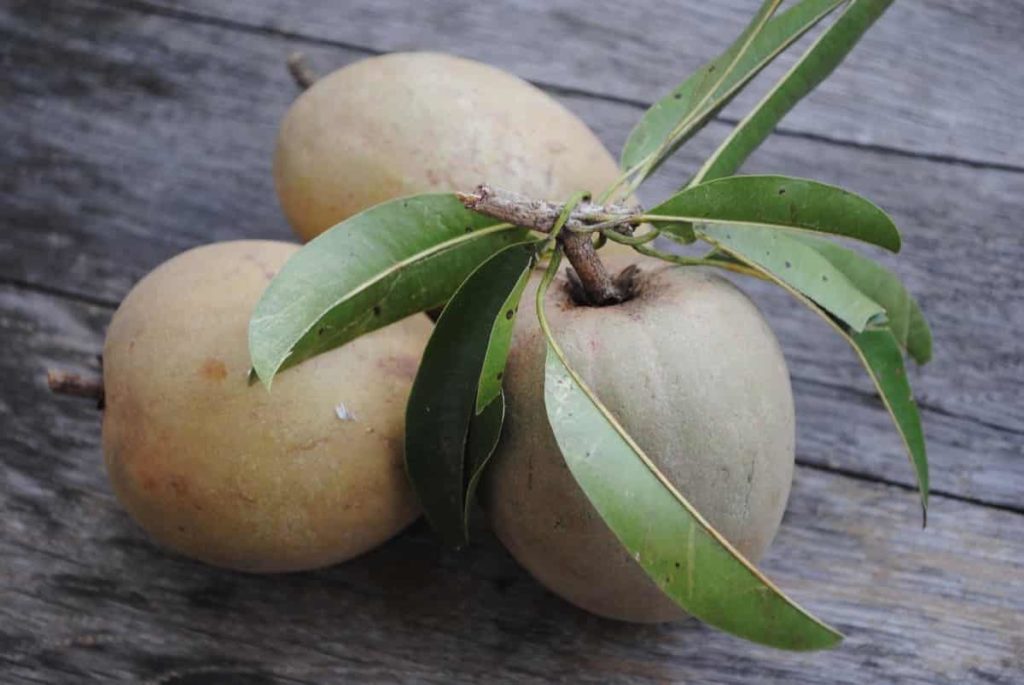
Potassium
Symptoms of potassium deficiency are light brown spots scattered all over the leaves which later appear and form necrotic spots between the large veins—Browning of the chlorotic spots on the underside of leaves and between the veins due to K deficiency.
Correction measurement: Using KCl at 80 kg/hectare. Apply K2SO4 to Sapota plants instead of potassium chloride.
Zinc
Deficiency Symptoms – Zinc deficiency is characterized by short, straight leaves. Defoliation of small internodes and terminals and poor fruiting in field conditions.
Remedies – Reducing zinc sulfate (0.2 to 0.5%) during active growth can be remedied.
Magnesium
Symptoms of magnesium deficiency – The leaves turn light green, gradually turning greenish-yellow, dark green with the middle ribs and large veins. The leaves turned yellow with a brown wound scattered on the leaf blades. Intravenous chlorosis on older leaves followed by necrosis of the distal edge of the leaves.
Correction measurements can be avoided using dolomite or spraying magnesium nitrate at 1%.
Copper
Symptoms of copper deficiency include reddish-brown color in the veins of the leaves, premature defoliation, and twigs of the leaves. Several buds came from the tips of the twigs, which soon died.
Correction measurement – Application CuSO4 5 to 10 kg / ha. Q fungicide sprays will help eliminate the deficiency.
Iron
Symptoms of Deficiency – Iron chlorosis in calcareous soils usually occurs with the yellowing of the leaves. Premature leaf loss and dieback can occur.
In case you missed it: Sapota Farming (Chiku), Planting, Care, Harvesting
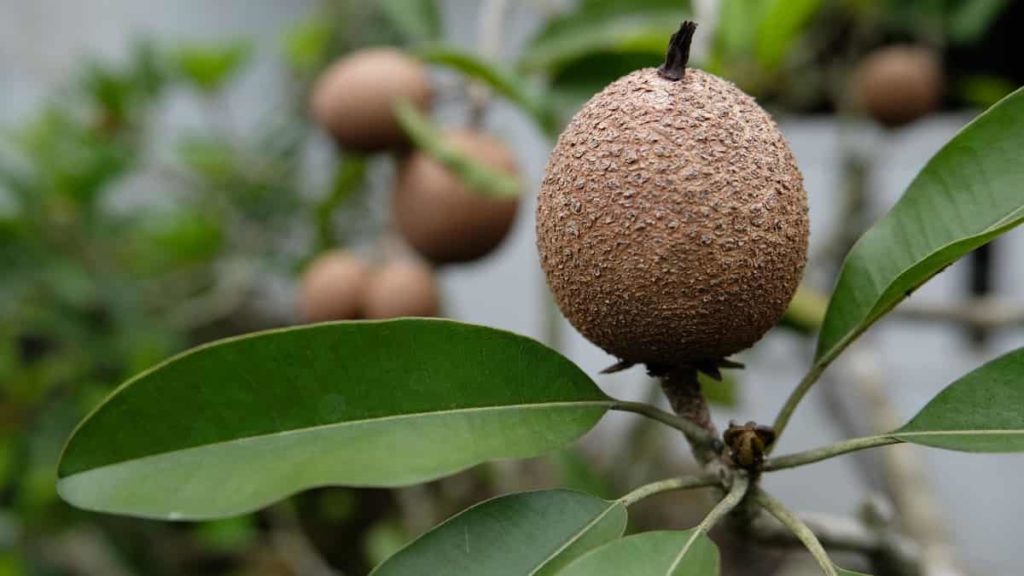
During active growth, treatment is corrected with a spray of ferrous sulfate (0.2 to 0.4%).
Boron
Symptoms of Deficiency – The crop is sensitive to boron deficiency. The leaves become chlorotic, and the branches begin to wither.
Treatment – It is recommended to spray Borax (0.05%) thrice a month from June.
Sulfur
Symptoms of Deficiency – Yellowing of young leaves; leaf growth is affected.
Correction measurement – CaSO4 @ 1% foliar spray
- Economical Aquaculture: A Guide to Low-Budget Fish Farming
- 15 Common Planting Errors That Can Doom Your Fruit Trees
- How to Make Houseplants Bushy: Effective Tips and Ideas
- Innovative Strategies for Boosting Coconut Pollination and Yield
- Pollination Strategies for Maximum Pumpkin Yield
- The Complete Guide to Chicken Fattening: Strategies for Maximum Growth
- Natural Solutions for Tulip Problems: 100% Effective Remedies for Leaf and Bulb-Related Issues
- Revolutionizing Citrus Preservation: Towards a Healthier, Greener Future
- Natural Solutions for Peony Leaf and Flower Problems: 100% Effective Remedies
- Maximizing Profits with Avocado Contract Farming in India: A Comprehensive Guide
- Natural Solutions for Hydrangea Problems: 100% Effective Remedies for Leaf and Flowers
- The Ultimate Guide to Choosing the Perfect Foliage Friend: Bringing Life Indoors
- From Sunlight to Sustainability: 15 Ways to Use Solar Technology in Agriculture
- The Ultimate Guide to Dong Tao Chicken: Exploring from History to Raising
- The Eco-Friendly Makeover: How to Convert Your Unused Swimming Pool into a Fish Pond
- Mastering the Art of Delaware Chicken Farming: Essentials for Healthy Backyard Flocks
- 20 Best Homemade Fertilizers for Money Plant: DIY Recipes and Application Methods
- How to Craft a Comprehensive Free-Range Chicken Farming Business Plan
- Brighten Your Flock: Raising Easter Egger Chickens for Beauty and Bounty
- How to Optimize Your Poultry Egg Farm Business Plan with These Strategies
- Subsidy for Spirulina Cultivation: How Indian Government Schemes Encouraging Spirulina Farmers
- Ultimate Guide to Raising Dominique Chickens: Breeding, Feeding, Egg-Production, and Care
- Mastering the Art of Raising Jersey Giant Chickens: Care, Feeding, and More
- Ultimate Guide to Raising Legbar Chickens: Breeding, Farming Practices, Diet, Egg-Production
- How to Raise Welsummer Chickens: A Comprehensive Guide for Beginners
- How to Protect Indoor Plants in Winter: A Comprehensive Guide
- Ultimate Guide to Grow Bag Gardening: Tips, Tricks, and Planting Ideas for Urban Gardeners
- Guide to Lotus Cultivation: How to Propagate, Plant, Grow, Care, Cost, and Profit
- Agriculture Drone Subsidy Scheme: Government Kisan Subsidy, License, and How to Apply Online
- Ultimate Guide to Raising Araucana Chickens: Breed Profile, Farming Economics, Diet, and Care
- Bringing Hydroponics to Classroom: Importance, Benefits of Learning for School Students
- Ultimate Guide to Raising Polish Chickens: Breed Profile, Farming Economics, Diet, and Care
- Ultimate Guide to Raising Australorp Chickens: Profile, Farming Economics, Egg Production, Diet, and Care
- Silkie Chicken Farming: Raising Practices, Varieties, Egg Production, Diet, and Care
- Sussex Chicken Farming: Raising Practices, Varieties, Egg Production, Diet and Care
- Homemade Feed Formulations for Livestock: Discover Cost-effective Starter to Finisher Feed Recipes